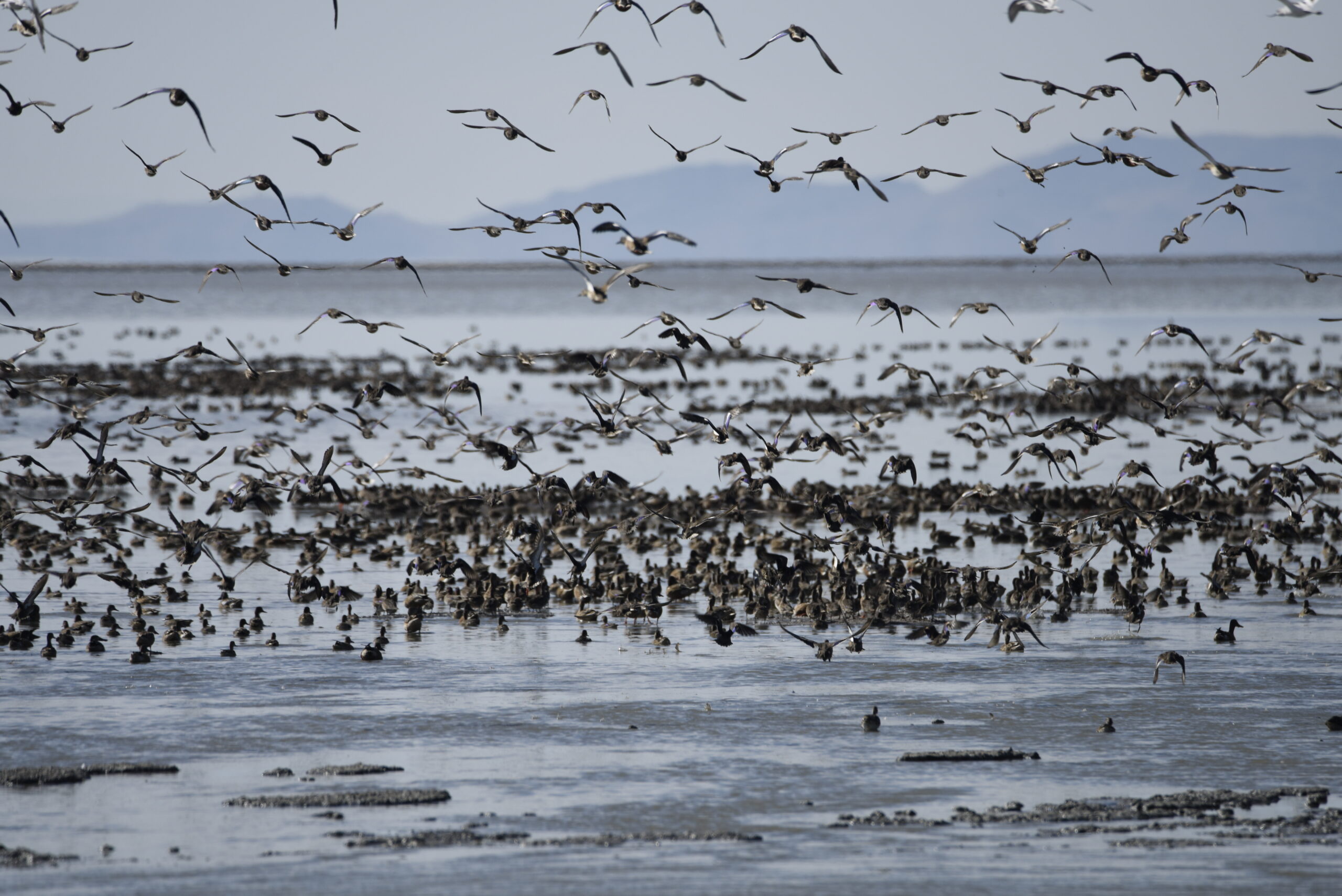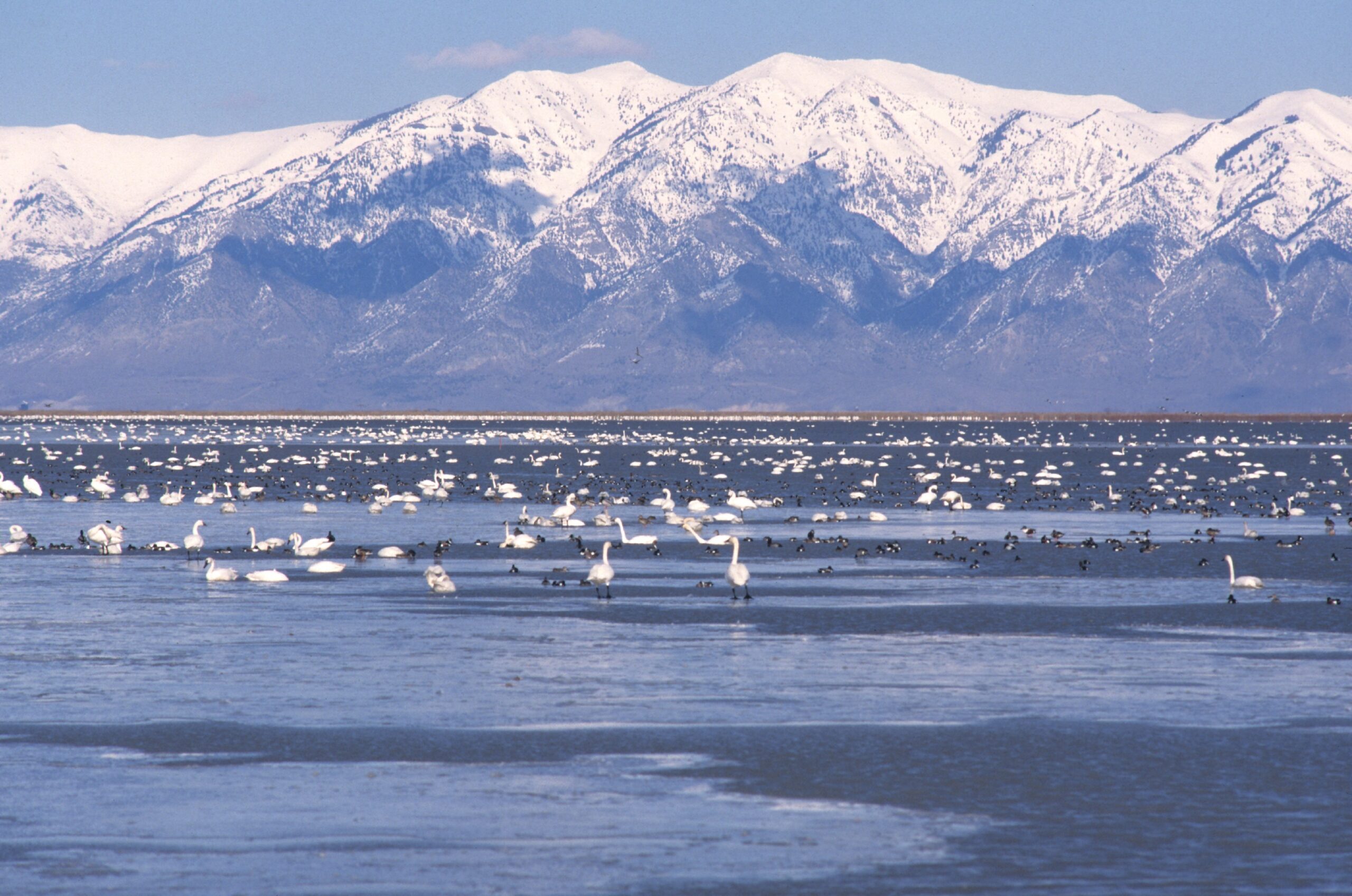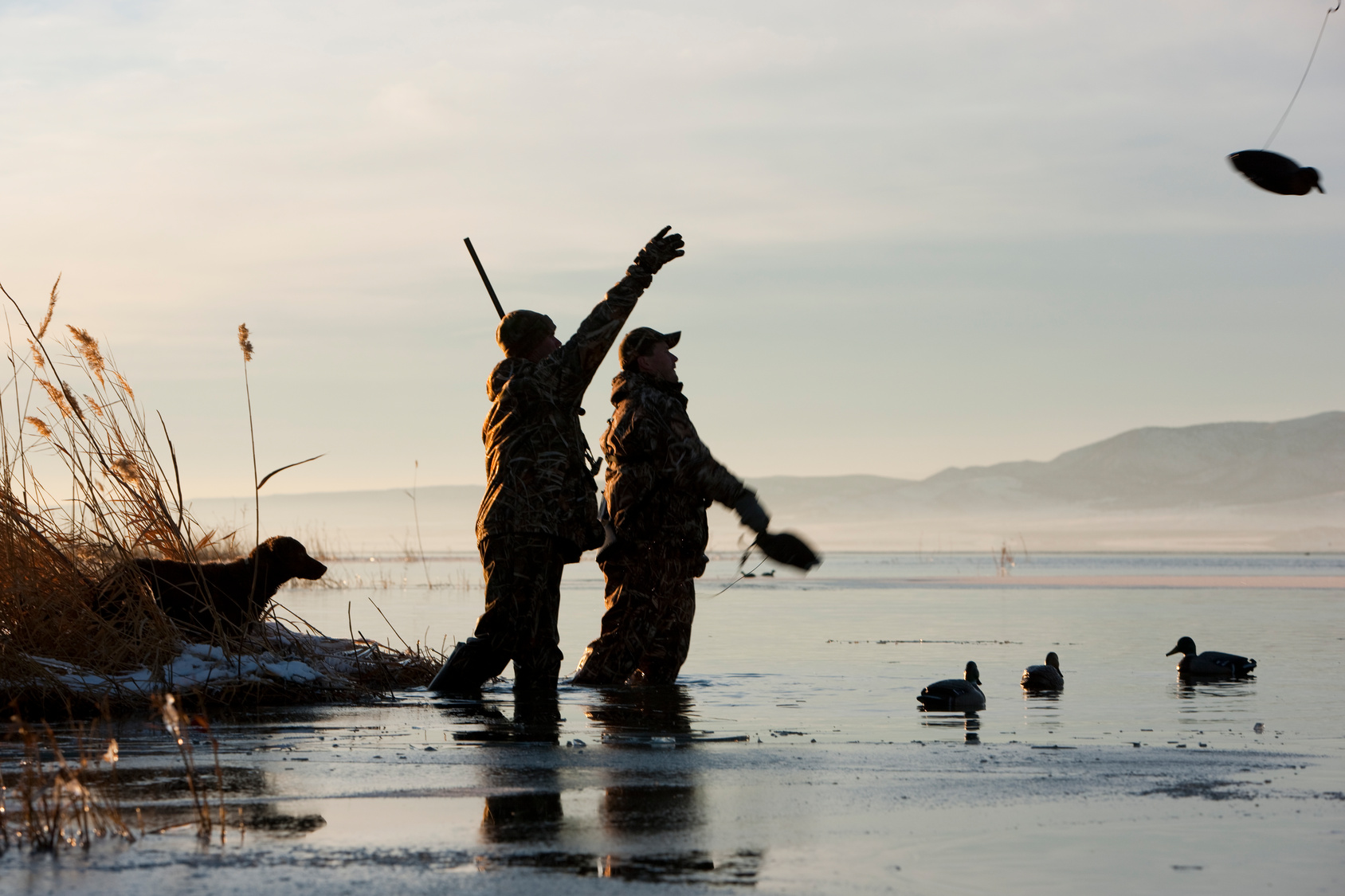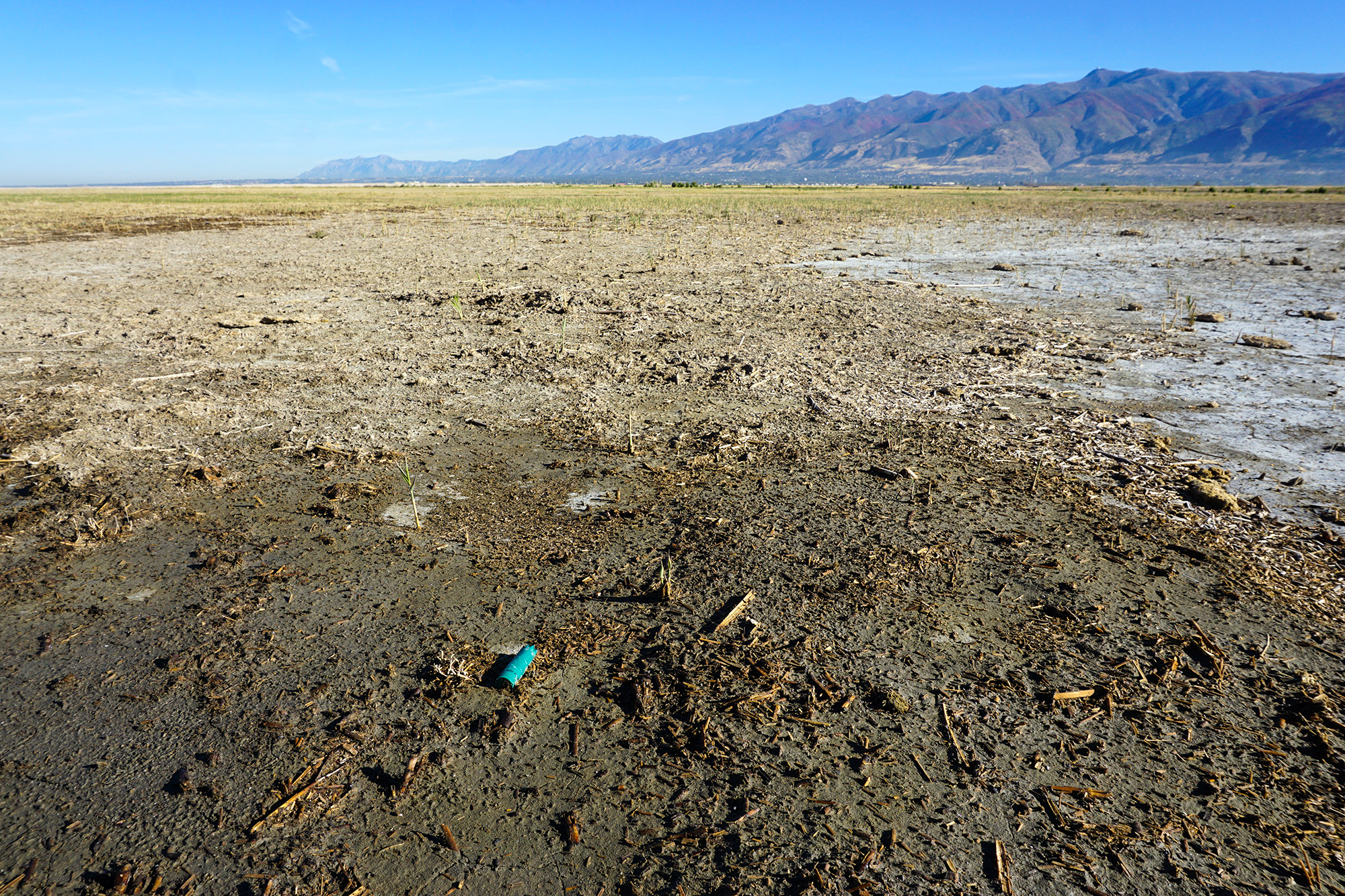PERRY HALL has celebrated his birthday the same way for the last 12 years. Every sixth of October, he wakes up well before the sun creeps over the Wasatch Mountains of northeastern Utah. He hitches his boat trailer to his old Tacoma and loads the topped truck bed with waders, decoys, a 12 gauge, and plenty of shells. His Lab, Lottie, rides shotgun all the way to the Farmington Bay Waterfowl Management Area. And each year, she fetches Hall’s birds from the Great Salt Lake.
This season is different.
“I just got off the water,” Hall sighed into the phone last month, the night before his 36th birthday. “I don’t think I’m hunting tomorrow. There’s nothing out there. I didn’t see a single duck tonight.”
Locals like Hall will tell you the Wasatch Front wasn’t always like this. Even just a decade ago, the duck hunting on the Great Salt Lake was lights out, with public-land and private-club hunters shooting teal, pintails, and mallards during fast-and-furious hunts. But as chronic drought (the worst megadrought to hit the Wasatch Front since 800 A.D.), higher temps, diverted water, and a skyrocketing human population have descended on the West, the Pacific Flyway is more strained than ever before. Ducks and geese are getting desperate—and sick—as they’re forced to fly greater distances for less water and forage, especially as the other two crucial habitat areas in the Pacific Flyway dry up. The Great Salt Lake should be the desert oasis that saves the day, a quenching port in the dust storm.
Instead, it’s going down the drain. And it’s taking Perry’s birthday duck hunting tradition with it.

Growing Populations, Shrinking Habitat
The Wasatch Front stretches from Logan to Provo, with Salt Lake City sprawling about two thirds of the way down the roughly 100-by-10-mile valley. The Wasatch Range to the east and the Great Salt Lake to the west provide equally dramatic backdrops to this sprawling metropolis. Subdivision streets creep into every nook and cranny between business parks, shopping malls, and sloping foothills, and a heavy sprinkle of 15,000-square-foot mansions look down from higher elevations.
It’s the same story in many cities out West, from Albuquerque to Bozeman to Colorado Springs. Most patches of dirt are under construction or staked with big “For Sale” signs. Housing prices are soaring, along with homelessness rates.
The population of Utah was over 1.6 million in 1986. Today, it’s twice that, and on track to double in the coming decades. Worse, an estimated 90 percent of that population lives in the Wasatch Front. More people require more water, and that extra demand is straining a watershed that’s already taxed. Marry this overdraft with the effects of climate change, and the Great Salt Lake lowers with every passing year. Much of the surface area around the eastern shore is exposed mud or hard, cracked earth. As if the receding lake weren’t bad enough, that dirt contains a toxic blend of metals like arsenic, which have been contained for a thousand years. Now the wind picks up these heavy metals and blows them to the neighboring cities, potentially sickening humans, pets, and livestock.


This phenomenon has happened before, but not on this scale. A rerun of the Owens Lake disaster looms over the Wasatch Front these days. That lake shriveled to nothing in 1926 after Los Angeles city planners sucked all the water over to their growing metropolis.
“Now the winds blow toxic dust into that little valley every year,” says Ducks Unlimited water outreach specialist and Utah representative Casey Snider. “But that was a small town a hundred years ago and a lake that was a fraction of the size of the Great Salt Lake. This is 90 percent of Utah’s population right here, who very soon could be breathing in dust that has all sorts of garbage in it. That’s the human dimension of this, and when you combine human catastrophe with ecological collapse, that’s a recipe for disaster.”
Gov. Spencer Cox received backlash this summer when he asked Utahns to join him in “praying collaboratively and collectively, asking God or whatever higher power you believe in for more rain,” while continuing to shorten showers, fix faucets, and plant water-wise landscapes.

The lake reached a record low exactly a month later, when scientists recorded the Great Salt Lake’s water level at 4,190 feet above sea level on July 3, 2022. It held a little over a quarter of the water, and about half the surface area that it did in 1986. This prompted Gov. Cox to suspend all new applications for water rights in the Great Salt Lake Basin via proclamation on Nov. 3. This move won’t affect current water users and their rights to surface water and groundwater in the basin, but it does restrict new water rights with few exceptions.
The Wasatch Front is also home to a lot of Kentucky bluegrass. Lawns have become cause for major controversy in the area. Members of the Church of Jesus Christ of Latter-day Saints pour plenty of water into maintaining their landscaping. The LDS Church addressed this issue in June when it announced plans to further water conservation efforts by planting more native species and altering landscapes and lawns. But many homeowners and businesses remain guilty of maintaining thick grass in the desert.
This landscaping problem is made possible, in part, because Utah has the cheapest water in the country, thanks to government subsidies funded by property taxes. This might seem strange for a conservative state that largely believes in limited taxation and the free market. But whether it’s drinking water or unfiltered irrigation water, there is little financial incentive to curb water use. Other Western towns charge for water based on use, which naturally reduces water waste. If Utah doesn’t make progress with its water conservation soon, Snider says the outlook is bleak—not just for ducks and hunters, but for all wildlife and Utahns.
“We’d be looking at significant collapse of migratory bird populations. And beyond that, maybe you don’t care about wildlife, and that’s certainly your prerogative, but if Great Salt Lake turns into Owens Lake, then everybody in this valley is going to care.”

Wildlife Refuges Are a Bear to Manage
The Bear River is 350 miles long, making it the longest closed-basin river in the country. It starts in the Uinta Mountains and carves through high desert, cattle ranches, and sagebrush in Utah, Wyoming, and Idaho before emptying into the Great Salt Lake. The Bear provides two-thirds of the Great Salt Lake’s water, but much of that is drawn for ag, cattle, and city water long before it arrives.
Few places feel this strain more than the Bear River Migratory Bird Refuge, where the Bear River empties into the northern end of the lake. The Refuge, which is owned and operated by the U.S. Fish and Wildlife Service, manages two-thirds of the Great Salt Lake’s inflows through a series of levies, impoundments, and water-control structures while putting up with drought, water-guzzling invasive species, avian botulism outbreaks, high costs, and other barriers.
“This refuge is a very managed landscape that relies on the water of the Bear River to support hundreds of thousands of migratory birds that come through here,” says Erin Holmes, the Refuge project lead. “So it’s a bit of an oasis in the middle of the desert.”
Lately, it’s only been an oasis for part of the year. The Refuge’s water right, one of the biggest and oldest in the area, takes priority from Oct. 1 to May. But for the remainder of the year, irrigators take precedence.
“The state of Utah does not recognize water rights as beneficial for wildlife,” Holmes says. “[The water] goes straight to irrigation, which is fine, because people need to grow their crops and eat. But that means in the summertime, there simply isn’t any water available.”
And when summer flows are lacking, fall migration conditions at the Refuge are rough.
“When we don’t have water in the summertime, we can’t provide any habitat for birds [during the fall],” she says. “It used to be that there was plenty of water in the system. The Bear River watershed had lots of water. But now with the drought, there’s not enough.”
So how do you manage water when there’s not enough? Holmes and her small team sprint around the Refuge’s 77,000 acres and 96 miles of dikes and levies to adjust water-control structures. Some structures involve manually dropping 60 or 70 long wooden slats into wide-set grooves like a game of Connect-4 to create blockages. Others are more advanced and easier to use but also pricier.
“It’s kind of a juggling game. It’s really science but it’s also art,” Holmes says. “Sometimes it looks like a Picasso painting, sometimes it looks like Monet, sometimes it looks like something I would draw, which is not very pretty. But you just have to [be flexible and manage] based on conditions.”

A Disappearing Flyway
Even when badly needed rain or snowmelt does flow into the Great Salt Lake, it can become too much of a good thing for migratory waterfowl. When certain parts of the Refuge flood, the threat of avian botulism explodes. Botulism occurs naturally in the soils of the Great Salt Lake—soils that are now being exposed to air for the first time in modern history. When the exposed lakebed floods, it can create prime conditions for bacteria growth. Ducks get sick and die, only to become hosts for maggots and other insects that healthy ducks eat.
“For waterfowl this can be catastrophic, because they can’t hold their heads up and they drown,” says Holmes. Extreme muscle weakness is a symptom of botulism. “I remember going out on an airboat and seeing ducks’ [bills] just barely above the water.”
Drought is a problem that reaches far beyond the Great Salt Lake. If you zoom out and look at the whole Pacific flyway, it relies on three crucial stopover areas: the Klamath Basin, California’s Central Valley, and the Great Salt Lake. According to Mark Petrie, the director of conservation planning at Ducks Unlimited, these three landscapes are like dominoes. Once one falls, the others will, too. Between September and April, 70 percent of the ducks within the American Pacific Flyway will be resting and feeding at these three areas.

One domino is already flat on its back. Two other historically rich and productive waterfowl areas in the Klamath Basin, the Lower Klamath and Tule Lake national wildlife refuges, went completely dry this year, prompting a bird hunting closure for the 2022 to 2023 season. Meanwhile drought conditions have also worsened in the Central Valley, where rice and other crop production is struggling. Petrie is most concerned about food resources for migrating waterfowl.
“Here’s something that keeps me up at night,” Petrie says. “Eighty percent of all foraging habitat for ducks in the Big Three need annual deliveries of water supplies. Every year, we have to get annual water supplies to provide most of the food that has traditionally been supplied in these three landscapes.”
Petrie contrasts available resources in the Pacific Flyway with those in the Mississippi and Atlantic flyways. If drought occurs in those regions, ducks can rely on coastal and Mississippi River-adjacent wetlands to support their food demands.
“But 80 percent of coastal wetlands on the Pacific coast have been lost,” Petrie says. “This part of the world just doesn’t have the capacity to handle the overflow or additional demand birds would put on those environments when the Big Three dry. So there aren’t a lot of places these birds can turn.”

Hunting the Once-Great Salt Lake
The Great Salt Lake has long been known to host some of the best waterfowl hunting in the West. It serves up access to public waters and marshes and private duck clubs alike. Utah representative and Ducks Unlimited water outreach specialist Casey Snider remembers what it was like to hunt waterfowl along the Wasatch Front as a kid.
“At about three in the morning, we would pile our decoys on our backs and tie our guns to our handlebars and we would ride the dike as far as we could, and then in the dead of night we would take our guns and decoys off and hide our bikes in the cattails,” Snider recalls. “The canal was too deep to wade across, so you would throw your decoys in and then jump on your decoys and kick and paddle across the canal until you hit enough mud to stand in. And then you’d trudge for a mile until you could set up.”
To Snider, the effort was worth it for the quality of duck hunting he enjoyed. Things have changed for him, just like they have for every other waterfowler on the Wasatch Front. Because the lake reached a record high just 36 years ago, plenty of Utahns remember when things were different. This change hasn’t been a slow one. In geological terms, the lake’s recession practically happened overnight.

“I don’t even run my airboat anymore. Everywhere I used to run it is dry,” Snider says. He looks out over the dehydrated flats around Antelope Island and points out the Farmington Bay WMA on the southeastern shore of the lake, where Perry Hall normally spends his birthday hunting. The Bay is all but cut off from the rest of the lake by exposed ground. Just a single channel east of Antelope Island keeps the two connected.
A few days later, Hall’s champagne Tacoma bounces down the access road to Farmington Bay in the early morning darkness.
“I don’t think the majority of duck hunters in Utah realize the severity of the situation,” Hall says as he digs around in his truck. “The majority of duck hunting in northern Utah is done in water-controlled and diked units, like Farmington Bay and Bear River Migratory Bird Refuge. So there is a decent amount of water inside the dikes of the unit, but once you get outside the dikes, the situation is much worse. And I don’t think duck hunters realize that because they come out and see water.”
Sure enough, as we drive along the access road, it looks like there’s plenty of water. If I hadn’t seen the area surrounding the Farmington Bay from Antelope Island three days prior, I wouldn’t realize the severity of the situation either.
Hall describes when early season at Farmington Bay sounded like the Battle of Gettysburg and pellets would rain down from the sky all morning. But today it’s quiet as the sun climbs the east side of the Wasatch, even though trucks with boat trailers are parked around the area.

Drought and development have combined to create a bit of a paradox: more hunters chasing what seems to be fewer ducks. Some reports show that the lower water levels are actually better for duck hunting in the short term, since the birds concentrate in a smaller area. But such a conclusion neglects the fact that there will be more hunters targeting ducks in fewer spots with less overall habitat.
Hall looks at his shotgun and leaves it behind, officially breaking the birthday tradition. Five minutes after first shooting light, a duck flies overhead. We see just five on our walk, not even enough to fill a limit, in an area that should hold thousands this time of year.
“I realize how good it was eight or nine years ago when I started hunting out here and how quickly it’s deteriorating,” Hall says as he tosses a stick for Lottie. “There’s a lot of environmental factors at play with ducks, since they’re migratory. You have to think about weather patterns, not only here but in northern Canada, Alaska, for breeding populations in the Pothole region, which is also facing a drought.”

Solutions to problems caused by drought might seem obvious. While disincentivizing or suppressing further real estate development might seem like a stretch, Gov. Cox’s latest move to restrict access to new water rights will impact new construction. Other megadrought states enforce strict water limitations for current users and charge more for using more. But Utah’s government seems hesitant to institute any other restrictions. Participation in water conservation is voluntary, and there are no consequences for turning a blind eye and maintaining status quo. But Hall hopes duck hunters will feel spurred to action by the risks posed to their favorite pastime.
“As hunters, shouldn’t we be the ones? We’re all ‘conservation this’ and ‘conservation that,’ and ‘look at what our dollars do,’” Hall says. “But if we don’t do anything about climate change happening around the world, then what are we doing? We’re not living up to that message that we’re talking and pounding our chests about all the time.”
After Hall drives off, I walk onto a mud flat that probably held water not too long ago and nearly step on a 12-gauge shell lodged in the mud. The letters “Remin” are inked clearly on the side, the “gton” smudged from years of exposure to the briny muck. It’s a relic of a recent past that longtime Utah duck hunters remember well. Another morning—not far from here—I spot a father and son decked in camo and waders, dragging a sled full of decoys across the mud. But there is no water in sight.
Read more OL+ stories.
